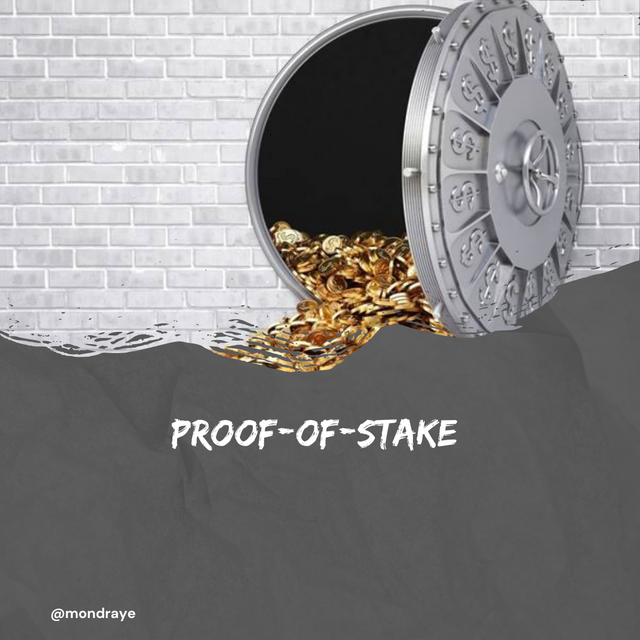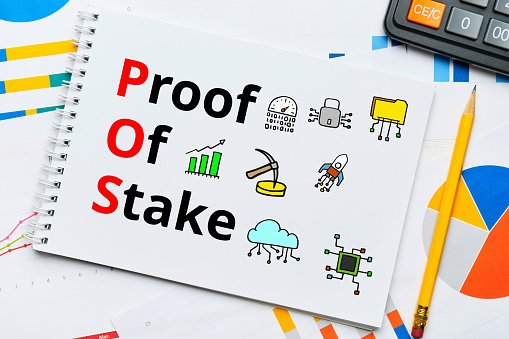THE PROOF-OF-STAKE CONCENSUS MECHANISM
Greetings,
It's your friend @mondraye, and today we will be talking about the emergence of Proof-of-Stake.

I would like to send my sincere thanks to the administrators and moderators of this community before I introduce the topic.
We'll talk about the proof-of-stake consensus mechanism today.
The birth of the financial crisis in 2008 sparked the development of bitcoin, and its popularity sparked the formation of additional cryptocurrencies.
The development of the blockchain, which aids in transaction validation, has been made possible by the global advancement of technology and its impact on the financial sector.
The proof of stake consensus mechanism is one of the methods the blockchain utilizes to validate transactions because it does not accept the involvement of a third party.
Proof of stake is a consensus mechanism for cryptocurrencies that is used to validate transactions on a blockchain and create new blocks.
A consensus mechanism can be defined as a technique for validating and securing entries that are sent into a distributed database.
The blockchain is a distributed database that is made safe by a consensus mechanism in the case of cryptocurrencies.
The computational labor required to guarantee the complete security of the blockchain and cryptocurrency is reduced thanks to the proof of stake mechanism.
The computational labor required to guarantee the complete security of the blockchain and cryptocurrency is reduced thanks to the proof of stake mechanism.
Proof of stake uses an alternative technique to verify blocks utilizing the computing power of coin holders.
To be given an opportunity to validate a block, coin owners must first contribute their coin.
The proof of stake consensus mechanism was established in 2011 with the goal of replacing the time- and resource-intensive proof of work consensus technique.
In contrast to the pow consensus mechanism, which uses a competition-based approach, the coin owners who staked their coins are known as as validators in the proof of stake system and are chosen at random to validate a block.
The Ethereum network, for example, requires a total of 32Eth from a coin owner in order for him to be a validator. A coin owner must stake a specific amount of coin in order to qualify to be a validator.
With the POS mechanism, multiple validators are utilized to certify a transaction's authenticity, and the block is then confirmed once all of them have done so.
The pos mechanism, as I previously stated, uses a variety of techniques to validate a block.
Shards are used by Ethereum whenever it moves to the point of sale to submit transactions.
The transaction will first be verified by a validator before being put to the shard block, where it will need to be verified by an additional 128 validators.
After the shard has been verified and the block has been generated, it must have the approval of two-thirds of the validators in order to be sealed.
Some examples of Blockchain that makes use of PROOF-OF-STAKE include;
- Solana
- Cardona
- Avalanche
- Polkadot
- Binance Smart Chain
- Cosmos
- Vchain
- Tezos
- Terra
Being that the Proof-of-Stake consensus mechanism was introduced to be an amendment to the Proof-of-Work, it has series of advantages and some of them will be explained below.
- Decentralization
Pos mechanisms have the benefit of being decentralized, allowing any user to take part as a validator as long as they possess the necessary token.
Furthermore, it is very cheap to purchase this token, which encourages competition among individuals for the position of validator.
- Security
Security is another benefit of the pos mechanism because it prevents hackers from accessing more than 51% of the total token supply without losing a significant portion of it.
- Scalability
One feature that makes the pos mechanism scalable is its capacity to handle numerous transactions at once.
One reason it was created as an alternative to the pow consensus technique is its scalability feature.
- Energy reservation
The pos mechanism doesn't require the usage of a high energy machine to solve a high energy demanding challenge, in contrast to the pow consensus mechanism.
Thus, since the pos mechanism doesn't release any harmful gases, it can be regarded to be more ecologically friendly. to the environment
- Low transaction fee
There's considerably a low transaction fee on blockchains that operates on the Proof-of-Stake mechanism when compared to proof-of-work. This is mostly because multiple transactions can be verified at once thus living no room for congestion which normally result to high transaction cost.
In as much as the Proof-of-Stake consensus mechanism has series of advantages, there are also some disadvantages because nothing can be entirely perfect.
Some of this disadvantages includes;
- Low security level
Despite the fact that we talked about how the pos method is safe because it demands that the attacker control at least 51% of the token,
In most circumstances, if the attacker can persuade others that his attack will be 90% successful, owning a 51% stake in the token can be cheap, and as a result, other coin owners may elect to sell their token at a discount price.
- Complexity
Other regulations have been put in place in order to prevent problems like "nothing at stake" or "far range attacks" from negatively impacting the blockchain.
The mechanism is made more difficult by the way block validators are chosen.
- Distribution
We know from our course of study that a user must stake coins in order to be a validator on the point-of-sale system.
We also know that these currencies are initially obtained through block validation, therefore in a sense, no one would be a validator in the absence of coin staking.
Additionally, coins cannot be distributed without validators.
The only way to resolve this issue is to pre-mine coins, which will then be distributed across the addresses in the genesis block.
For the fact that the Proof-of-Stake mechanism was introduced to enhance the performance of the proof-of-work mechanism has often made both to be compared and some of their similarities will be explained below.
🔰For transaction validation, proof of stake and proof of work mechanisms are both highly helpful.
🔰They both work to prevent third parties from interfering with bitcoin transactions because they are decentralized.
🔰Despite using distinct strategies, they both work to keep the blockchain they are using secure.
🔰They both promote a sense of community among their users, which is another similarity between them.
Now that we have compared their similarities, let's further looks at some of the differences they have.
| PROOF-OF-STAKE | PROOF-OF-WORK |
|---|---|
| Because proof of stake does not require the use of an energy-intensive machine for block validation, it is more environmental friendly. | During the mining process, proof of work emits harmful carbon emissions, making it unfriendly to the environment. |
| Since Proof of Stake doesn't require complicated computers, operating it costs less money. | Because it calls for the employment of sophisticated equipment to solve intricate mathematical puzzles, proof of work is exceedingly expensive. |
| Since proof of stake's criterion can be met by the majority of individuals, it encourages more people to engage and compete for the position of a block validator. | Only the wealthy can afford sophisticated processors that can be used to validate blocks using the proof of work mechanism. |
| A proof of stake mechanism completes many transactions relatively quickly. | The transaction rate for proof of work is slower than that for proof of stake. |
| The transaction charge for a proof of stake transaction is quite low. | Worker verification is combined with a high transaction cost. |
| Compared to proof of work, proof of stake is less secure since an attacker can simply persuade other coin users to support his attack. | Since proof of work takes a sophisticated machine to operate, it is more secure than pos. |
A very significant consensus method called proof of stake was created as a replacement for pow, which had a reputation for having high transaction costs and energy consumption.
Even if the pos has certain distinctive qualities, the pow still seems to be more secure, which prompted the development of additional consensus mechanisms such as Dpos, Pob, etc.

Tweet
https://twitter.com/SonOfMaaan/status/1563907681789820929?s=19
Proof of Stake transaction fee is very cheap compare to proof of work and this makes it interesting.
Thank you so much for going through my post.
I really appreciate
Note: You must enter the tag #fintech among the first 4 tags for your post to be reviewed.
PoS has huge advantage over PoW. Nice share.
Thank you for you comment.
Please I will be needing the discord ticket
Try get help channel in our discord server and mention any of our moderators.
Ok
Thank you
Proof Of Stake has proven to be better than Proof Of work
You are right.. That explains why Ethereum is moving from POW to POS
This is wonderful, thank you for sharing this detailed information with us today Success to us.
Thank you for appreciating my content. I believe you learnt something tangible from it.
I will also endevour to provide beneficial contents for readers.